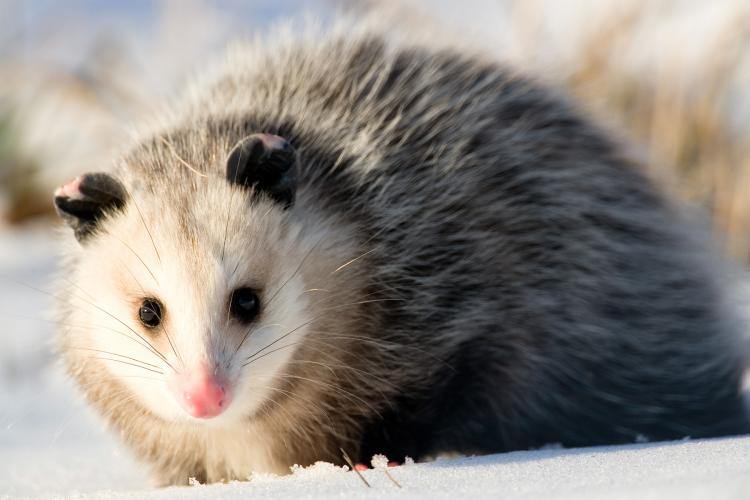Sometimes you have to be sneaky to survive.
When a predator catches an opossum by surprise, the opossum often collapses, appearing to be dead. Its breathing slows down. It slobbers, blows snot bubbles out of its nose, and it may even release a slimy green fluid from its rear end that makes the opossum smell even worse than usual. Yuck! Most predators lose their appetite at this point and leave the opossum alone.
This behavior — called “playing possum” — is a useful trick that helps opossums survive. But these furry fakers aren’t the only animals with a prank up their paws. Read on to learn about other animal tricksters.
Fakey Snake
Sometimes called a puff adder, the harmless hog-nosed snake sure looks deadly. When it feels threatened, it hisses loudly and flattens its head like a cobra. But the snake is a big fake. If its bluff fails, the hog-nose squirms around, rolls onto its back, flops out its tongue, and pretends to be dead. If left alone, the sneaky snake will slowly turn right-side-up, peek around to make sure it’s safe, and then slither away to shelter.
Humbug
Bold colors are nature’s way of saying,
“Back off, I’m dangerous.” Take, for example, this bumblebee. The black and yellow bands on its body warn other animals that it packs a painful sting. But here’s where it gets tricky. This isn’t a bee. It’s a clearwing moth, and it can’t sting. Pretending to be a bumblebee helps the tasty moth avoid getting gobbled by birds. The moth’s wings even buzz like a bumblebee when the moth hovers over flowers.
Bird-Dropping Disguise
Wait a second. Did that bird dropping just move? This giant swallowtail caterpillar will turn into a beautiful butterfly someday. But as a baby it looks like, well, poop. And that isn’t an accident. Birds eat caterpillars the way baseball fans snarf down hotdogs. But what bird would eat a caterpillar that looks like this? A swallowtail’s disguise is so good that young caterpillars don’t even try to hide. They usually rest in plain sight on top of leaves — exactly where bird droppings would be expected.
Cattail Camouflage
If birds played hide-and-seek, American bitterns would win every time. When predators come prowling, a bittern doesn’t flinch a feather. Instead, the brown-streaked bird freezes and points its beak skyward. Sometimes a bittern will rock back and forth, hoping to look like a cattail swaying in the breeze. Bitterns hide so well that they are more often heard than seen. Their mating call — a booming unk-alunk — can carry half a mile across the marshes where they live.
Tail Trickery
When a snake bites a five-lined skink on the tail, the little lizard leaves its behind behind. By flexing special muscles, the skink snaps off its own back end. The muscles also pinch blood vessels shut so the lopped-off lizard doesn’t bleed to death. While the detached tail twitches, the muchshorter skink slinks to safety. It takes three or four months for the skink to grow a new tail, and it’s often shorter than the original.
Fake a Break
If a hungry coyote gets too close to a killdeer’s nest, the mom or dad killdeer runs away while pretending to have a broken wing. The bird puts on quite an act, thrashing around and dragging its wing pitifully. The coyote follows the “injured” actor, hoping to score an easy meal. But when the predator has been led far away from the nest, the killdeer quickly “heals” and flies to safety.
Prankster Parenting
When there’s a bumper crop of insects to eat, black-billed cuckoos often lay extra eggs — just not in their own nests. Mother cuckoos sneak around, leaving their eggs in the nests of robins and other birds. The foster parents raise the cuckoo chicks as if they were their own, with zero help from the mother or father cuckoo. Cuckoo chicks grow faster than other chicks, which means the foster parents spend most of their time feeding the cuckoos instead of their own babies.
My, What Big Eyes You Have
When a luna moth feels threatened, it unfolds its flappers to reveal spots that look like large, glaring eyes. The eyespots startle would-be predators, giving the moth time to get away. But that isn’t the only trick lunas employ. The moth’s long fluttering tails confuse hungry bats, knocking the predators’ attacks off target. A bat may get a mouthful of moth tail — ouch! — but the luna survives to fly another night.


And More...
This Issue's Staff
Les Fortenberry
Karen Hudson
Angie Daly Morfeld
Noppadol Paothong
Marci Porter
Mark Raithel
Laura Scheuler
Matt Seek
David Stonner
Nichole LeClair Terrill
Stephanie Thurber
Cliff White






















